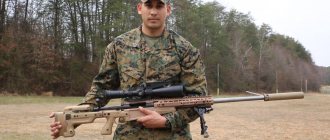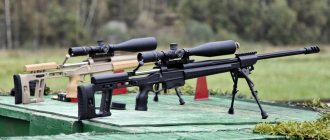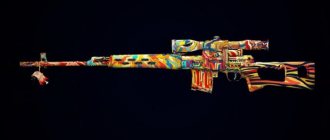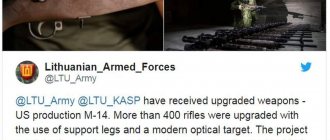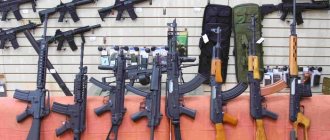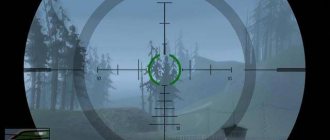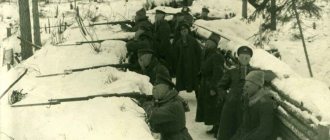| ORSIS T-5000 | |
| Type | sniper rifle |
| A country | Russia |
| Service history | |
| In service | Special Operations Forces of the Russian Federation, FSB of Russia, FSO, Russian Guard |
| Production history | |
| Designed by | 2011 |
| Years of production | 2016 - present |
| Characteristics | |
| Weight, kg | 6.1/6.3 (.308 Winchester) 6.5 (.338 Lapua Magnum) |
| Length, mm | Unfolded: 1270 (.338 Lapua Magnum) 1060/1230 (.308 Winchester) Closed: 1020 (.338 Lapua Magnum) 810/960 (.308 Winchester) |
| Barrel length, mm | 508/673.1 (.308 Winchester) 698.5 (.338 Lapua Magnum) |
| Caliber, mm | 7.62x51 mm (.308 Winchester), 7.62x67 mm (.300 Winchester Magnum), 8.6x70 mm (.338 Lapua Magnum) |
| Work principles | longitudinally sliding bolt with manual reloading |
| Initial bullet speed, m/s | 925 |
| Sighting range, m | 1000 (.308) or 1500 (.338) - practical |
| Type of ammunition | detachable magazine for 5 or 10 rounds |
| Media files on Wikimedia Commons | |
ORSIS T-5000
(from Russian weapon systems; also ORSIS T-5000) is a high-precision bolt-action repeating sniper rifle. Produced by the arms manufacturer of the Promtekhnologii industrial group, located in Moscow. Currently, the rifle is sold only in a civilian version; the cost of the rifle is about 390,000 rubles. The rifle was presented in 2011 at the international Russian arms exhibition in Nizhny Tagil. These rifles can be used by both special law enforcement units and specially trained army snipers.
At the beginning of June 2012, the team of Directorate “A” of the FSB TsSN won the international police and military sniper world cup competition using T-5000 rifles[1].
In September 2012, the rifle was tested as part of the “Ratnik” equipment set for the ground forces[2].
In 2020, as part of the “Accuracy” sniper complex, it was adopted by the Special Operations Forces, the FSB of Russia, the FSO, and the Russian Guard.
Design
The design of the T-5000 is based on the original bolt group made of stainless steel. The shutter is longitudinally sliding, rotary. The barrel and trigger mechanism of the rifle are also made of stainless steel. The T-5000 is equipped with an ORSIS SE barrel produced by the single-pass cutting method. The manufacturing accuracy of the barrel is about 0.002 mm. The barrel length is 27.5 inches (698.5 mm), the muzzle diameter is 22 mm. Fullers are made on the barrel to reduce the cooling time of the barrel and to reduce the weight of the weapon as a whole. The muzzle of the barrel has a thread for attaching a muzzle brake-compensator or other muzzle devices (equipped with a three-chamber muzzle brake-compensator ORSIS).
Aluminum alloy stock, ergonomic pistol grip, adjustable stock, folding stock mechanism made of steel with a magnetic lock in the folded position. Depending on the version of the trigger mechanism, the trigger force can be smoothly adjusted (“Hunter” - allows you to adjust the free play and force from 900 to 1500 grams; “Varmint” - from 500 to 900 grams). The three-position safety is located in the rear part of the bolt and, if necessary, allows you to manipulate the bolt with the safety on, or completely block the trigger and bolt. The rifle is equipped with a Picatinny rail type rail for installing an optical sight and a rail for installing a pre-objective attachment.
Optical sights for rifles are supplied by [3].
Cartridges are fed from detachable box magazines with a capacity of 5 and 10 rounds.
The stock is folding and adjustable in length. The buttstock has a height-adjustable cheek pad.
History of creation
There are many glorious pages in the Russian and Soviet arms industry. The names of weapons designers Mosin, Degtyarev, Tokarev, Kalashnikov are known throughout the world. In the sniper class, the Dragunov sniper rifle (SVD), widely used in Russian security forces, has recently become popular. But time passed and its technical indicators began to yield to foreign analogues. Thus, targeted shooting at a running figure is possible at a range of no more than 640 meters, and the maximum range does not exceed 1300 m based on the capabilities of the PSO - 1 sight installed on it. For comparison, the German analogue DR - 1 shows the following results - the target range is around 1400 m, American M200 - 1900 m. In both cases, we talk about targeted shooting. An attempt to modernize the SVD to increase its flight range by increasing the caliber of the cartridge did not have a positive result. It was necessary to use foreign-made sniper weapons in special teams of various military departments.
Therefore, the appearance in 2011 of the T-5000 sniper rifle, the brainchild of Moscow (weapon systems), representing , caused joy among Russian security forces. In Russia, weapons have appeared that can compete with the best foreign models. This was proven by the victorious performance of the FSB unit armed with it at international competitions in Hungary among police and military snipers. The birth of the T-5000 is the merit, first of all, of the company’s chief designer A.M. Sorokin and D.Yu. Semizorov, who took an active part in the development, refinement and testing of the project’s product.
Read AK-12 assault rifle - the future of the Russian army
Purpose and performance characteristics
The tactical and technical characteristics of the ORSIS T-5000 rifle allow you to hit targets at any time of the day or night, in any weather conditions, without preliminary shooting and technical training at distances of up to 1650 meters. ORSIS rifles demonstrated accuracy of fire at a level not exceeding 0.5 arc minutes (11 cm at 800 m).
The T-5000 is superior in range and accuracy to the Austrian SSG 08 rifle (purchased for snipers) and the Russian SV-98. The upgraded version of the T-5000M will in the future allow firing at a range of up to 2000 m[3].
The “Accuracy” sniper complex is available in two versions: for calibers 7.62/51 mm and 8.6/69 mm.
The development of a complex for anti-terrorism activities on the instructions of the Russian special services and the Russian Ministry of Defense became known in 2013. It was first presented during the Army 2015 forum.
The release of “Precision” in two modifications with different calibers is due to the peculiarity of bullet ballistics. So, for maximum accuracy at a distance of up to 500-800 meters, 7.62/51 mm is suitable. An 8.6/69 mm caliber will ensure effective engagement of a target at a distance of 1.5 kilometers.
This rifle is based on the original bolt group. The latter, like the barrel and trigger mechanism, are made of stainless steel.
The rifle stock, which serves to connect all parts and make it easier to use when shooting, is made of an aluminum alloy with increased wear resistance. The ergonomic pistol grip, adjustable stock, and folding stock mechanism are made of steel with a magnetic lock in the folded position. The three-position safety is located at the rear of the bolt. If necessary, it allows you to manipulate the bolt with the safety on, or completely block the trigger and bolt.
The weight of the complex ranges from 5.8 to 6.2 kilograms. Its tactical and technical characteristics allow it to hit targets at any time of the day and in any weather conditions without preliminary shooting and technical training. During testing, it was demonstrated that the rifle remains operational even when cooled to minus 50 degrees, as well as in conditions of high humidity.
general information
In the arms business, the sniper rifle has a place of honor and is considered a special, elite class. It received this position based on the specifics of the work of snipers in modern combat conditions. Innovative developments in the military industry require constant and rapid modernization of sniper weapons in order to stay ahead of the intended rival. Continuous improvement is being carried out on the following parameters
- Increased reliability of all parts;
- Increased accuracy, range and accuracy in shooting;
- Reducing the size of the rifle and its weight, in order to increase convenience for the sniper;
- Constant improvement of optical devices for successful operation at any time of the day and in bad weather.
Russian sniper rifle T-5000 - a world-class weapon
Using its experience in the Syrian conflict, Russia has developed several new modifications of the T-5000 sniper rifle. After the demonstration of the rifle's capabilities, the demand for new weapons increased. The T-5000 was developed back in 2011, during which time several generations of prototypes and pre-production models appeared. The rifle was used in the Caucasus, where terrorist activity is still observed. Over the past five years, most terrorists have left the Caucasus and headed to Syria, Iraq and Afghanistan, but some of them have remained in southern Russia. Terrorism in these territories is considered the biggest threat, and Russian snipers from army units and units of the Ministry of Internal Affairs receive new weapons before others, especially if they are sent to a combat zone.
Russian snipers have been dreaming of a rifle like the T-5000 ever since new designs were introduced to the West after the Cold War. Russia could not compete with Western countries in terms of weapons production until it gained official access to Western technologies and markets. This happened in the 1990s, and Russian enterprises began to produce more and more world-class weapons. Over time, manufacturers in Russia entered the Western market for service and civilian weapons. For example, for the T-5000 model to be successful, most of the rifles must be purchased by the civilian population.
Special operations forces sent to Syria after 2014 (before the “official” deployment of troops in mid-2020) were likely armed with T-5000 rifles. Rumors about the rifle's range, accuracy and convenience began to spread in security circles, and demand for the weapon increased. Foreign customers appeared (Saudi Arabia, Iraq, Vietnam, Syria and China). The problem was that ORSIS (Russian rifle manufacturer) was not fulfilling orders quickly enough. By the end of 2020, production volumes increased significantly, and key customers received rifles of the latest version of the T-5000M.
Since 2014, reports have increasingly appeared that Russia is developing a radically new (for Russia) T-5000 sniper rifle. Testing of weapons based on recent Western developments began in 2011. Over the course of several years, the T-5000 was tested and refined, and the production model was named T-5000M. This is a bolt-action sniper rifle with a mass of 6.5 kilograms, a barrel length of 66 centimeters, a magazine for 5 (or 10) rounds and a Picatinny rail. The weight and length of the rifle depends on the caliber. The T-5000 is designed to fire standard NATO 7.62x51mm (.308 Winchester), .300 Winchester Magnum or .338 (8.6mm) Lapua Magnum cartridges. When firing 8.6 mm cartridges, the firing range of the T-5000 rifle exceeds 2000 meters. The appearance and functionality of the T-5000 resembles Western models. Russia plans to sell most of the T-5000 abroad (prices start at $6,000), but Russia's elite sniper units will also receive new weapons. Snipers who had the opportunity to “test” the T-5000 in the Caucasus will be able to use the new rifle on an ongoing basis.
Russia has tried to modernize its Cold War-era troops by adopting the best technology and experience from the West. As part of this process, the new T-5000 appeared. The rifle was created with the expectation of more active use of snipers. Since 2010, Russia has sent its most talented recruits to three-month sniper courses. Through mobilization and other methods, Russia planned to acquire an additional 1 thousand snipers by 2016. Apparently, the Russian troops succeeded in this, and thanks to the Internet, newly minted snipers learned about the rifles that their Western colleagues have, and wanted to get weapons of the same quality. Some Russian snipers have begun to master Western models, but Russia does not want to equip its troops with foreign-made weapons.
Even during World War II, Russia successfully used snipers and developed many tactics and training methods. Interestingly, Western armies still use them today. The Russian military made one important conclusion: the quality of the rifle and equipment is not as important as the selection and training of the sniper. During the Cold War, the Russian army had only worn-out weapons and equipment at its disposal. Many people performed the duties mechanically, and Russia could no longer boast of skilled snipers. Let's not forget that during World War II, the best Russian snipers were mostly women, but that's another story.
In the 21st century, America uses snipers most effectively. Since 2001, the US Army and Marine Corps have changed the way they train snipers. Perhaps this is due to the fact that many snipers have received serious combat experience. They apply their knowledge by training new snipers. The three main American structures that train snipers (Army, Marines and Special Forces) began to cooperate more closely with each other. Previously, each of the structures practiced its approach separately from the others. But after 2001, competitions and general events began, at which snipers from these structures exchanged information about tactics, techniques and combat experience. The number of snipers grew, and the development and production of various types of sniper weapons and equipment began. This is partly due to the fact that many civilians have become addicted to sniping as a sport. While many civilian shooters are former military, these shooters mostly want to learn how to hunt with the latest weapons or improve their training.
In 2004, the US Army, following the example of the Marine Corps, began training new snipers, so their number will soon more than triple. In terms of the number of snipers, the ground forces and marines are almost equal. To “catch up” with the Marines, the US Army has tripled enrollment in sniper schools. Army snipers undergo 5 weeks of training, while Marine Corps sniper training (considered one of the best in the world) lasts 10 weeks. After training, professional snipers are able to independently conduct operations with a team of two people.
Previously, Marine battalions had three times as many snipers as Army battalions. Previously, there were only 6-8 snipers per infantry battalion. Thanks to additional training, snipers appeared in every department. There are 27 squads in an infantry battalion.
The ground forces and marines use the experience of soldiers who managed to take part in hostilities. In addition, almost every soldier is armed with a rifle with a scope, and he knows how to use it thanks to frequent shooting. In the past, infantry commanders designated about 10 percent of their men as "sharpshooters" (sort of marksmen), tasked with killing enemy soldiers from long range with a single shot. This tactic gained popularity in the 1990s and became a hallmark of the US infantry. Sharp shooters (especially those who had fought in war) became the main candidates for snipers. However, a professional sniper has specialized skills that include the ability to find the best shooting position, the ability to move unnoticed, and the ability to hide once detected. Trained snipers have proven their effectiveness on the battlefields of Afghanistan and Iraq. The enemy is afraid of snipers, and their presence limits the movement of enemy shooters.
In Russia there are not many infantrymen who have had the opportunity to take part in battles, and there are not many volunteers ready to serve in the ground forces.
But in Russia, conscripts are carefully selected, and young men with the potential to perform special tasks (management, maintenance, special operations, sniper shooting) are given the opportunity to serve in more suitable conditions than ordinary recruits. China uses the Western model because the country has many volunteers and is not alien to Western methods. Share… VK 0

